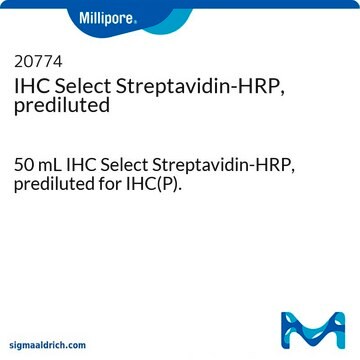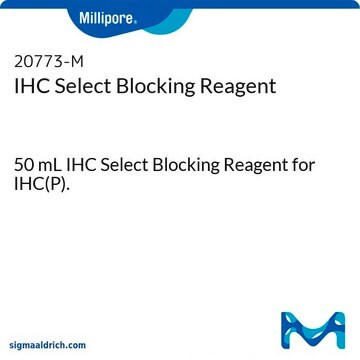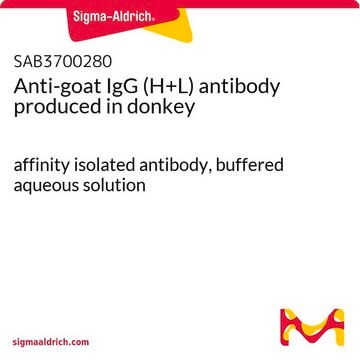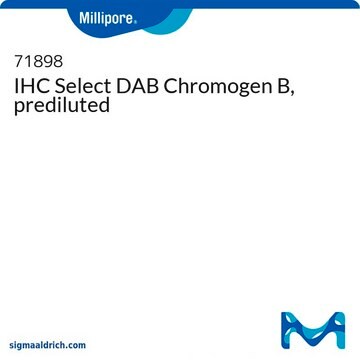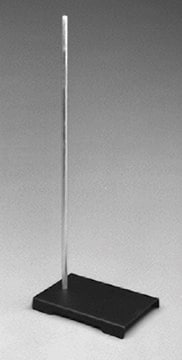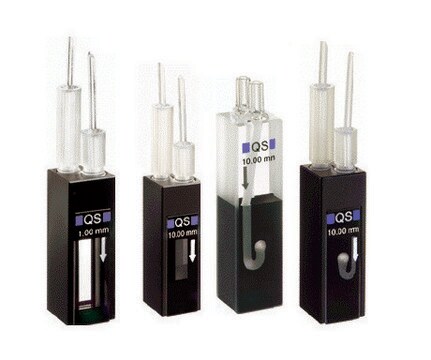DET-HP1000
IHC Select HRP Detection Set, (Blocking Reagent, Biotinylated linking Riagent and SA_HRP), Prediluted
IHC Select HRP Detection Set, (Blocking Reagent, Biotinylated linking Riagent & SA_HRP), Prediluted for Immunohistochemistry (Paraffin).
ログイン組織・契約価格を表示する
すべての画像(1)
About This Item
UNSPSCコード:
41116010
eCl@ss:
42029053
NACRES:
NB.22
おすすめの製品
化学種の反応性
mouse, rabbit
メーカー/製品名
Chemicon®
IHC Select
テクニック
immunohistochemistry: suitable (paraffin)
検出方法
colorimetric
輸送温度
wet ice
詳細
Intended Use
The IHC Select Immunoperoxidase Secondary Detection System is intended for use with the CHEMICON IHC Select Prediluted Primary Antibody reagents, which contain rabbit and mouse IgG for the qualitative identification of antigens by light microscopy in paraffin-embedded tissues. The IHC Select Immunoperoxidase Secondary Detection System may also be used with other rabbit or mouse primary antibodies.
General Purpose Reagents
Principle of Procedure:
The IHC Select Immunoperoxidase Secondary Detection System uses biotin-avidin-HRP complexed antibodies to detect rabbit or mouse IgG in the Primary Antibody. The primary antibody binds to specific antigens present in the specimen. Any excess antibody is removed by washing. Next, the Secondary Antibodies Reagent (conjugated to biotin) is added and will react with the primary antibody present on the tissue. Unbound antibody is removed by washing. The sample is then by incubated with the Streptavidin-HRP solution, which binds to the biotin-labeled secondary antibody present on the tissue. Unbound enzyme is removed by washing. The chromogenic development reagent, 3,3′ diaminobenzidine (DAB Substrate), is then added and reacts with the HRP attached to the HRP-streptavidin-biotin-antibody complex. The HRP activity on the chromogenic substrate results in the deposit of brown to black insoluble precipitate at those antigenic sites containing the specific epitopes recognized by the primary antibody. Tissues processed in a variety of fixatives including neutral buffered formalin, B-5, and Bouin′s may be used.
Summary and Explanation:
Immunohistochemical techniques have been in use for the recognition of cells in tissue sections for at least 50 years. The first method reported use of fluorescent labels in 19411. In 1974, reports of using enzymatic labels, such as horseradish peroxidase (HRP) in routine H & E paraffin sections appeared2,3. The methods have since become the ′standard of care′ in surgical pathology when classic methods alone fail to yield a definitive diagnosis4-9.
Early techniques were based on the peroxidase-anti-peroxidase (PAP) reaction, while improvements exploited the strong affinity of avidin for biotin10. This technique uses HRP-labeled streptavidin. The secondary antibody is conjugated with biotin and the Strepavidin-HRP complex reacts with the biotin on the secondary antibodies. The resulting biotin-avidin-HRP complex can react with the primary antibody bound to the specific epitope of the target antigen. The HRP enzymes of the streptavidin complex then catalyze the substrate/chromogen reaction to form a coloured reaction product (brown to black when using DAB as the chromogen) at the antigen site. A biological stain (counterstain) is then used to visualize the tissue structure.
The IHC Select Immunoperoxidase Secondary Detection System is intended for use with the CHEMICON IHC Select Prediluted Primary Antibody reagents, which contain rabbit and mouse IgG for the qualitative identification of antigens by light microscopy in paraffin-embedded tissues. The IHC Select Immunoperoxidase Secondary Detection System may also be used with other rabbit or mouse primary antibodies.
General Purpose Reagents
Principle of Procedure:
The IHC Select Immunoperoxidase Secondary Detection System uses biotin-avidin-HRP complexed antibodies to detect rabbit or mouse IgG in the Primary Antibody. The primary antibody binds to specific antigens present in the specimen. Any excess antibody is removed by washing. Next, the Secondary Antibodies Reagent (conjugated to biotin) is added and will react with the primary antibody present on the tissue. Unbound antibody is removed by washing. The sample is then by incubated with the Streptavidin-HRP solution, which binds to the biotin-labeled secondary antibody present on the tissue. Unbound enzyme is removed by washing. The chromogenic development reagent, 3,3′ diaminobenzidine (DAB Substrate), is then added and reacts with the HRP attached to the HRP-streptavidin-biotin-antibody complex. The HRP activity on the chromogenic substrate results in the deposit of brown to black insoluble precipitate at those antigenic sites containing the specific epitopes recognized by the primary antibody. Tissues processed in a variety of fixatives including neutral buffered formalin, B-5, and Bouin′s may be used.
Summary and Explanation:
Immunohistochemical techniques have been in use for the recognition of cells in tissue sections for at least 50 years. The first method reported use of fluorescent labels in 19411. In 1974, reports of using enzymatic labels, such as horseradish peroxidase (HRP) in routine H & E paraffin sections appeared2,3. The methods have since become the ′standard of care′ in surgical pathology when classic methods alone fail to yield a definitive diagnosis4-9.
Early techniques were based on the peroxidase-anti-peroxidase (PAP) reaction, while improvements exploited the strong affinity of avidin for biotin10. This technique uses HRP-labeled streptavidin. The secondary antibody is conjugated with biotin and the Strepavidin-HRP complex reacts with the biotin on the secondary antibodies. The resulting biotin-avidin-HRP complex can react with the primary antibody bound to the specific epitope of the target antigen. The HRP enzymes of the streptavidin complex then catalyze the substrate/chromogen reaction to form a coloured reaction product (brown to black when using DAB as the chromogen) at the antigen site. A biological stain (counterstain) is then used to visualize the tissue structure.
関連事項
Replaces: 2240
保管および安定性
When stored at 2 - 8°C, the IHC Select Immunoperoxidase Secondary Detection System is stable up to the expiration date printed on the kit label. Do not freeze or expose to elevated temperatures. Discard any remaining reagents after the expiration date. Do not store kit components or perform staining in strong light, such as direct sunlight.
Precautions:
· Pooling, substitution or alteration of any reagent may cause erroneous results.
* Do not mix reagents from different lots.
* Do not allow the slides to dry at any time during the staining procedure.
* Handle all specimens and materials coming in contact with them as potentially infectious materials. Disinfect with 0.05% sodium hypochlorite.
* Do not mouth pipette reagents. If ingested, seek professional assistance or contact a Poison Control Centre immediately.
· Diaminobenzidine (DAB) may be carcinogenic. This solution may cause irritation upon skin contact. Avoid inhalation, ingestion, or skin contact and wear gloves when handling DAB. If skin contact occurs, flush affected area with water. Spills may be ′neutralized′ with bleach25,26. Dispose of according to local regulations.
· Inhalation or ingestion of xylene or the highly allergenic fixative formaldehyde is harmful. These materials should be handled with gloves. Prepare in a fume hood. If skin or eye contact occurs, wash thoroughly with copious amounts of water.
· Wear disposable gloves when handling any human material and while performing the staining procedure.
Precautions:
· Pooling, substitution or alteration of any reagent may cause erroneous results.
* Do not mix reagents from different lots.
* Do not allow the slides to dry at any time during the staining procedure.
* Handle all specimens and materials coming in contact with them as potentially infectious materials. Disinfect with 0.05% sodium hypochlorite.
* Do not mouth pipette reagents. If ingested, seek professional assistance or contact a Poison Control Centre immediately.
· Diaminobenzidine (DAB) may be carcinogenic. This solution may cause irritation upon skin contact. Avoid inhalation, ingestion, or skin contact and wear gloves when handling DAB. If skin contact occurs, flush affected area with water. Spills may be ′neutralized′ with bleach25,26. Dispose of according to local regulations.
· Inhalation or ingestion of xylene or the highly allergenic fixative formaldehyde is harmful. These materials should be handled with gloves. Prepare in a fume hood. If skin or eye contact occurs, wash thoroughly with copious amounts of water.
· Wear disposable gloves when handling any human material and while performing the staining procedure.
法的情報
CHEMICON is a registered trademark of Merck KGaA, Darmstadt, Germany
免責事項
Unless otherwise stated in our catalog or other company documentation accompanying the product(s), our products are intended for research use only and are not to be used for any other purpose, which includes but is not limited to, unauthorized commercial uses, in vitro diagnostic uses, ex vivo or in vivo therapeutic uses or any type of consumption or application to humans or animals.
シグナルワード
Warning
危険有害性情報
危険有害性の分類
Aquatic Chronic 2 - Eye Irrit. 2 - Skin Irrit. 2 - Skin Sens. 1
保管分類コード
12 - Non Combustible Liquids
引火点(°F)
Not applicable
引火点(℃)
Not applicable
適用法令
試験研究用途を考慮した関連法令を主に挙げております。化学物質以外については、一部の情報のみ提供しています。 製品を安全かつ合法的に使用することは、使用者の義務です。最新情報により修正される場合があります。WEBの反映には時間を要することがあるため、適宜SDSをご参照ください。
毒物及び劇物取締法
キットコンポーネントの情報を参照してください
PRTR
キットコンポーネントの情報を参照してください
消防法
キットコンポーネントの情報を参照してください
労働安全衛生法名称等を表示すべき危険物及び有害物
キットコンポーネントの情報を参照してください
労働安全衛生法名称等を通知すべき危険物及び有害物
キットコンポーネントの情報を参照してください
カルタヘナ法
キットコンポーネントの情報を参照してください
Jan Code
キットコンポーネントの情報を参照してください
試験成績書(COA)
製品のロット番号・バッチ番号を入力して、試験成績書(COA) を検索できます。ロット番号・バッチ番号は、製品ラベルに「Lot」または「Batch」に続いて記載されています。
この製品を見ている人はこちらもチェック
ライフサイエンス、有機合成、材料科学、クロマトグラフィー、分析など、あらゆる分野の研究に経験のあるメンバーがおります。.
製品に関するお問い合わせはこちら(テクニカルサービス)
